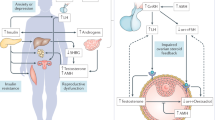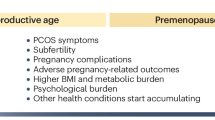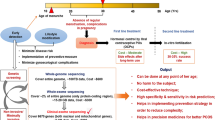Abstract
Polycystic ovary syndrome (PCOS) is strongly associated with hyperinsulinaemia and type II diabetes (T2D). Sequence variation within KCNJ11 (encoding Kir6.2, the beta- cell inwardly rectifying potassium channel) is implicated in the pathogenesis of neonatal diabetes, hyperinsulinaemia of infancy and multifactorial T2D. Comprehensive tagging studies have demonstrated that the KCNJ11 E23K variant (or ABCC8 A1369S in LD>0.9) is responsible for the known association between KCNJ11 and T2D. Given the phenotypic overlap between PCOS and T2D, we investigated whether E23K is involved in susceptibility to PCOS and related traits. Case–control analyses for the KCNJ11 E23K variant were performed in (a) 374 PCOS cases and 2574 controls of UK British/Irish origin, and (b) 550 women with PCOS symptoms and 1114 controls from a Finnish birth cohort. The relationship between E23K genotype and androgen levels (a key intermediate phenotype relevant to PCOS) in 1380 samples was studied. The UK case–control analysis revealed no association between E23K genotypes and PCOS status (P=0.49; Cochran–Armitage test), and no significant relationship between E23K genotype and androgen measures in the samples for which these phenotypes were available (P=0.19). Similarly, the Finnish case–control analysis showed no association between E23K genotypes and PCOS status (P=0.75; Cochran–Armitage test), and no significant relationship between E23K genotype and androgen measures in the samples for which these phenotypes were available (Finnish controls, P=0.25; Finnish cases, P=0.08). In conclusion, these data (involving >4600 subjects) provide no evidence that common variants of the KCNJ11 E23K polymorphism have a major influence on PCOS susceptibility, though modest effect sizes (OR<1.25) cannot be excluded.
Similar content being viewed by others
Log in or create a free account to read this content
Gain free access to this article, as well as selected content from this journal and more on nature.com
or
References
Asuncion M, Calvo RM, San Millan JL, Sancho J, Avila S, Escobar-Morreale HF : A prospective study of the prevalence of the polycystic ovary syndrome in unselected Caucasian women from Spain. J Clin Endocrinol Metab 2000; 85: 2434–2438.
Wild S, Pierpoint T, McKeigue P, Jacobs H : Cardiovascular disease in women with polycystic ovary syndrome at long-term follow-up: a retrospective cohort study. Clin Endocrinol 2000; 52: 595–600.
Azziz R, Ehrmann D, Legro RS et al: Troglitazone improves ovulation and hirsutism in the polycystic ovary syndrome: a multicenter, double blind, placebo-controlled trial. J Clin Endocrinol Metab 2001; 86: 1626–1632.
Holte J, Bergh T, Berne C, Wide L, Lithell H : Restored insulin sensitivity but persistently increased early insulin secretion after weight loss in obese women with polycystic ovary syndrome. J Clin Endocrinol Metab 1995; 80: 2586–2593.
Kiddy DS, Hamilton-Fairley D, Bush A et al: Improvement in endocrine and ovarian function during dietary treatment of obese women with polycystic ovary syndrome. Clin Endocrinol 1992; 36: 105–111.
Franks S : Polycystic ovary syndrome. N Engl J Med 1995; 333: 853–861.
Morin-Papunen LC, Vauhkonen I, Koivunen RM, Ruokonen A, Tapanainen JS : Insulin sensitivity, insulin secretion, and metabolic and hormonal parameters in healthy women and women with polycystic ovarian syndrome. Hum Reprod 2000; 15: 1266–1274.
Nestler JE, Strauss III JF : Insulin as an effector of human ovarian and adrenal steroid metabolism. Endocrinol Metab Clin N Am 1991; 20: 807–823.
Adashi EY, Hsueh AJ, Yen SS : Insulin enhancement of luteinizing hormone and follicle-stimulating hormone release by cultured pituitary cells. Endocrinology 1981; 108: 1441–1449.
Dunaif A : Insulin resistance and the polycystic ovary syndrome: mechanism and implications for pathogenesis. Endocr Rev 1997; 18: 774–800.
Nestler JE, Powers LP, Matt DW et al: A direct effect of hyperinsulinemia on serum sex hormone-binding globulin levels in obese women with the polycystic ovary syndrome. J Clin Endocrinol Metab 1991; 72: 83–89.
Yki-Jarvinen H, Makimattila S, Utriainen T, Rutanen EM : Portal insulin concentrations rather than insulin sensitivity regulate serum sex hormone-binding globulin and insulin-like growth factor binding protein 1 in vivo. J Clin Endocrinol Metab 1995; 80: 3227–3232.
Urbanek M, Woodroffe A, Ewens KG et al: Candidate gene region for polycystic ovary syndrome on chromosome 19p13.2. J Clin Endocrinol Metab 2005; 90: 6623–6629.
Gloyn AL, Pearson ER, Antcliff JF et al: Activating mutations in the gene encoding the ATP-sensitive potassium-channel subunit Kir6.2 and permanent neonatal diabetes. N Engl J Med 2004; 350: 1838–1849.
Thomas PM, Yuyang Y, Lightner E : Mutation of the pancreatic islet inward rectifier, Kir6.2 also leads to familial persistent hyperinsulinemic hypoglycemia of infancy. Hum Mol Genet 1996; 5: 1809–1812.
Florez J, Burtt N, de Bakker P et al: Haplotype structure and genotype–phenotype correlations of the sulfonylurea receptor and the islet ATP-sensitive potassium channel gene region. Diabetes 2004; 53: 1360–1368.
Gloyn AL, Weedon MN, Owen K et al: Large-scale association studies of variants in genes encoding the pancreatic beta-cell K-ATP channel subunits Kir6.2 (KCNJ11) and SUR1 (ABCC8) confirm that the KCNJ11 E23K variant is associated with type 2 diabetes. Diabetes 2003; 52: 568–572.
Schwanstecher C, Meyer U, Schwanstecher M : K(IR)6.2 polymorphism predisposes to type 2 diabetes by inducing overactivity of pancreatic beta-cell ATP-sensitive K(+) channels. Diabetes 2002; 51: 875–879.
Schwanstecher C, Schwanstecher M : Nucleotide sensitivity of pancreatic ATP-sensitive potassium channels and type 2 diabetes. Diabetes 2002; 51: S358–362.
The Rotterdam ESHRE/ASRM-sponsored PCOS Consensus Workshop Group: Revised 2003 consensus on diagnostic criteria and long-term health risks related to polycystic ovary syndrome (PCOS). Hum Reprod 2004; 19: 41–47.
Powell BL, Haddad L, Bennett A et al: Analysis of multiple data sets reveals no association between the insulin gene variable number tandem repeat element and polycystic ovary syndrome or related traits. J Clin Endocrinol Metab 2005; 90: 2988–2993.
Adams J, Polson DW, Franks S : Prevalence of polycystic ovaries in women with anovulation and idiopathic hirsutism. BMJ 1986; 293: 355–359.
Rantakallio P : The longitudinal study of the northern Finland birth cohort of 1966. Paediatr Perinat Epidemiol 1988; 2: 59–88.
Taponen S, Martikainen H, Jarvelin MR et al: Hormonal profile of women with self-reported symptoms of oligomenorrhea and/or hirsutism: Northern Finland birth cohort 1966 study. J Clin Endocrinol Metab 2003; 88: 141–147.
Taponen S, Martikainen H, Jarvelin MR et al: Metabolic cardiovascular disease risk factors in women with self-reported symptoms of oligomenorrhea and/or hirsutism: Northern Finland Birth Cohort 1966 Study. J Clin Endocrinol Metab 2004; 89: 2114–2118.
Taponen S, Ahonkallio S, Martikainen H et al: Prevalence of polycystic ovaries in women with self-reported symptoms of oligomenorrhoea and/or hirsutism: Northern Finland Birth Cohort 1966 Study. Hum Reprod 2004; 19: 1083–1088.
Inoue H, Ferrer J, Warren-Perry M et al: Sequence variants in the pancreatic Islet b-cell inwardly rectifying K+ channel Kir6.2 (Bir) gene. Identification and lack of role in Caucasian patients with NIDDM. Diabetes 1997; 46: 502–507.
Colhoun HM, McKeigue PM, Davey Smith G : Problems of reporting genetic associations with complex outcomes. Lancet 2003; 361: 865–872.
Laukkanen O, Pihlajamaki J, Lindstrom J et al: Polymorphisms of the SUR1 (ABCC8) and Kir6.2 (KCNJ11) genes predict the conversion from impaired glucose tolerance to type 2 diabetes. The Finnish Diabetes Prevention Study. J Clin Endocrinol Metab 2004; 89: 6286–6290.
Nielsen EM, Hansen L, Carstensen B et al: The E23K variant of Kir6.2 associates with impaired post-OGTT serum insulin response and increased risk of type 2 diabetes. Diabetes 2003; 52: 573–577.
Arslanian SA, Lewy VD, Danadian K : Glucose intolerance in obese adolescents with polycystic ovary syndrome: roles of insulin resistance and beta-cell dysfunction and risk of cardiovascular disease. J Clin Endocrinol Metab 2001; 86: 66–71.
Dunaif A, Finegood DT : Beta-cell dysfunction independent of obesity and glucose intolerance in the polycystic ovary syndrome. J Clin Endocrinol Metab 1996; 81: 942–947.
Ehrmann DA, Sturis J, Byrne MM, Karrison T, Rosenfield RL, Polonsky KS : Insulin secretory defects in polycystic ovary syndrome. Relationship to insulin sensitivity and family history of non-insulin-dependent diabetes mellitus. J Clin Invest 1995; 96: 520–527.
O'Meara NM, Blackman JD, Ehrmann DA et al: Defects in beta-cell function in functional ovarian hyperandrogenism. J Clin Endocrinol Metab 1993; 76: 1241–1247.
Goodarzi MO, Erickson S, Port SC, Jennrich RI, Korenman SG : Beta-cell function: a key pathological determinant in polycystic ovary syndrome. J Clin Endocrinol Metab 2005; 90: 310–315.
Vrbikova J, Bendlova B, Hill M, Vankova M, Vondra K, Starka L : Insulin sensitivity and beta-cell function in women with polycystic ovary syndrome. Diabetes Care 2002; 25: 1217–1222.
van Dam RM, Hoebee B, Seidell JC, Schaap MM, de Bruin TW, Feskens EJ : Common variants in the ATP-sensitive K+ channel genes KCNJ11 (Kir6.2) and ABCC8 (SUR1) in relation to glucose intolerance: population-based studies and meta-analyses. Diabet Med 2005; 22: 590–598.
Acknowledgements
We acknowledge the many patients, relatives, nurses and physicians who contributed to the ascertainment of the various clinical samples used in this study, and the UK Medical Research Council (Grant G9700120) for funding this work. We acknowledge the use of DNA from the British 1958 Birth Cohort and Finnish Cohort collections, funded by the UK Medical Research Council Grant G0000934 and Wellcome Trust Grant (GR069224MA, 068545/Z/02), respectively. We also acknowledge the Academy of Finland. Research Fellowships awarded by NovoNordisk (to TB) and Diabetes UK (to ALG).
Author information
Authors and Affiliations
Corresponding author
Additional information
This work was funded by Wellcome Trust (GR069224MA, 068545/Z/02), UK Medical Research Council (G9700120; G0000934), Academy of Finland, NovoNordisk Clinical Research Fellowship (TMB) and Diabetes UK RD Lawrence Research Fellowship (ALG).
Rights and permissions
About this article
Cite this article
Barber, T., Bennett, A., Gloyn, A. et al. Relationship between E23K (an established type II diabetes-susceptibility variant within KCNJ11), polycystic ovary syndrome and androgen levels. Eur J Hum Genet 15, 679–684 (2007). https://doi.org/10.1038/sj.ejhg.5201802
Received:
Revised:
Accepted:
Published:
Issue date:
DOI: https://doi.org/10.1038/sj.ejhg.5201802
Keywords
This article is cited by
-
Impact of variants on type-2 diabetes risk genes identified through genomewide association studies in polycystic ovary syndrome: a case–control study
Journal of Genetics (2018)
-
Polycystic ovary syndrome is not associated with genetic variants that mark risk of type 2 diabetes
Acta Diabetologica (2013)
-
Association of variants in the fat mass and obesity associated (FTO) gene with polycystic ovary syndrome
Diabetologia (2008)



